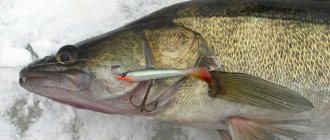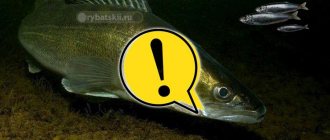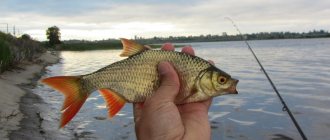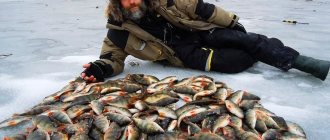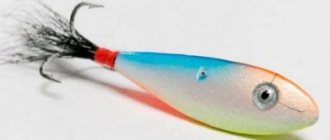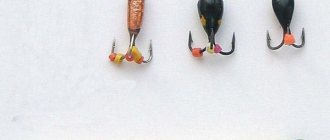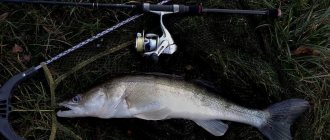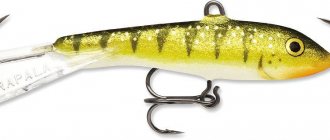Where and how to find predatory fish?
Regardless of what bait is used and what gear is used, there will be no effect from fishing if you do not determine the correct location where to find pike perch in the winter. Therefore, it is necessary to take into account the following features and recommendations of specialists:
- Pike perch is a schooling fish that prefers an active lifestyle. Therefore, it is almost constantly in a state of movement, migrating throughout the reservoir and looking for small fish or fry as food.
- The fanged one has developed vision, both linear and lateral. He has a well-developed sense of smell. All this helps it to be a very effective predator, despite the amount of light in the water.
- Food preferences include juveniles of different types of fish, for example, sprat, roach, bleak, small perch, etc. Moreover, this predator reacts better to a school of small fish, which it will willingly chase, as opposed to a single larger fish.
- There are “pike perch paths” - these are the main lines along which fish move as they migrate through a body of water in search of prey. But these lines are not stationary, they change from a combination of factors, such as the presence of currents, seasonality and weather conditions. If a fisherman finds himself on such a “pike perch trail,” then the effectiveness of his fishing is ensured by using the correct fishing technique and choosing the right bait. Therefore, if a pike perch was successfully caught in some place, then the next time you go you need to start from this location.
- The fish have clear priorities in terms of feeding time. Naturally, its maximum activity occurs in warm seasons, but this does not mean that in winter it is impossible to catch a sufficient number of specimens, which also differ in significant dimensions.
- Considering that part of the day when fish are most willing to bite on prey, it is worth noting the time intervals from 15 to 19 hours, and then the second peak occurs at night, until the morning hours.
- Considering the priority places for fish, it is worth paying attention to greater depths at this time of year. Both edges and river beds are suitable. You can also fish in flooded reservoirs. The fact is that this predator will always follow schools of young fish, which in the vast majority of cases move with the flow.
Winter record. Pike perch on Ratlin video
Having seen enough photographs of large perches that Sergey Karpov successfully catches from the ice on a Jackall TN60 rattlin, Maxim Dubkovsky decided to go to the Saratov Reservoir himself with winter gear. Extreme weather conditions did not stop our anglers from catching perch and pike perch using different types of bait, and at the end of the trip Maxim got a real “bonus” that every fan of vertical pike perch can envy.
This is interesting: The best weather for fishing
Read also: Universal echo sounder for winter and summer fishing
Features of gear suitable for catching pike perch in winter
In order to catch pike perch in the winter months, you can use typical gear, with some adaptation for this type of predator. Here's what it consists of and what you need to pay special attention to:
- The rod should be quite rigid and have a length of 0.4 m to 1 m.
- The reel must be of high quality and provide easy movement.
- It is imperative that there is a sensitive nod. It can be implemented in the form of a spring or a special metal plate.
- Fishing lines must be transparent and have a cross-section from 0.18 mm to 0.33 mm. Braided cords are also used. Here, a thinner section is allowed in the range from 0.14 mm to 0.2 mm.
- The tackle must be adjusted in such a way that the fisherman feels the lightest bite. This is necessary because this predatory fish first carefully touches the bait, and only then swallows it. This is especially noticeable when the pike perch cautiously approaches what looks to it like food.
Ways to catch pike perch in winter
In winter, pike perch are purposefully caught in two main ways:
- sheer glitter;
- zherlitsy.
The fishing rod for trolling should be light and durable with a small inertial reel.
The rod's whip needs to be stiff in order to cut through the pike perch's mouth. The length of the whip varies between 20-50 cm.
The tip of the fishing rod is equipped with a nod, which bends 10-30 degrees under the weight of the spoon. The most convenient is the reverse nod, which does not extend beyond the tip of the fishing rod.
Monofilament fishing line with a thickness of 0.25-0.4 mm is wound onto the reel. For light spinners you need to use thin fishing lines, and for heavy ones you need fishing lines with a larger diameter. Therefore, when fishing, it is better to take several reels with fishing lines of different thicknesses.
Catching pike perch in winter with zherlitsa is a popular way of catching pike perch using live bait. The number of designs and models of vents is very diverse, but they all must have certain properties.
The reel must be larger than 70mm in diameter and have some braking inertia. Thanks to this, there will be no unnecessary release of the fishing line when biting, and, accordingly, tangling of the tackle will be eliminated.
The reel must be more than 150 mm above the ice surface and under no circumstances should water come into contact with it. The bite alarm needs to be more sensitive than when fishing for pike; the plate with the flag should be released when hanging a load weighing 300-600 grams.
As for hooks, you can use single models No. 10-12 or doubles No. 7. 25-30 meters of monofilament with a thickness of 0.35-0.4 mm is wound onto the reel, and fishing line with a diameter of 0.3 mm is suitable for the leash.
Fishing methods and baits used
In order to catch pike perch on the first ice or throughout the winter, almost any type of winter fishing is suitable - jigs, balancers, spoons, small fish as live bait. All this can attract the attention of pike perch.
IMPORTANT!!! Therefore, we will further analyze the features and nuances of each technique in order to avoid failures when fishing in winter.
Flashing winter period
In order to implement this technique, you can use the following types of baits:
- Lure for the winter period. This is a fairly popular type of fishing. The geometry of the spinner can be gliding or diving. For an active predatory fish, a gliding fish is suitable, while for a passive fish, a diving fish is optimal. To enhance the effect, an additional piece of fish or fry is often added. This allows you to attract the predator even more intensely.
- The most similar to a regular spinner are amphipods.
- Balancers are used in the same way as other types of spinners, but taking into account the specifics of the game of this type of bait.
- Rattlins belong to the wobbler family and attract the attention of all types of predators, including pike perch. They are successfully used on spinning rods and for winter fishing.
Lure fishing technique
It is necessary to lower such an artificial fish first to the bottom, then with a sharp jerk make it rise approximately 0.5 m up and leave it to calmly sink to the bottom again.
Repeat these movements every 10 seconds. But keep in mind that such movements are made evenly, without allowing any failures or stops. But after 15 similar movements, if the predator has not responded to such bait, we can say for sure that it is not in the place under the hole. There is no point in trying your luck here any further; you need to move to another place.
As for color, yellow, red, or metal spoons work best, the lengths of which vary from 4 to 12 cm. As for weight, it is worth considering the following feature:
- In stagnant water the mass should be only up to 10 g.
- And when there is a current, it is necessary to give preference to spinners from 20 to 50 g.
Balancer fishing technique
This type of bait appeared not so long ago, but despite this, it has already gained its popularity. The principle of its operation is that it works in the vertical direction. Models can have either two hooks, located symmetrically on both sides. Or 3, with the third located on the model’s abdomen. This specific design was made so that an interested predator would no longer be able to escape from the angler’s fishing rod.
The technique is as follows:
- The bait sinks to the bottom.
- Then it rises very smoothly by 10 cm.
- Then the angler, with a sharp swing, raises it to another height of 50 cm.
- After which you need to wait for a pause for free fall.
- After 20 seconds, repeat the same action.
Due to the specific design and unique geometry, this bait not only performs a reciprocating movement up and down, but also deviates left and right at the same time. In this way, the developers managed to achieve maximum similarity to the behavior of a real fry.
Pike perch most often bites at the moment when the fish rises in the water and stops for a short period of time.
In some cases, for sluggish fish, tapping the bottom with a balancer is suitable. This way you can even interest a fish in a state of apathy.
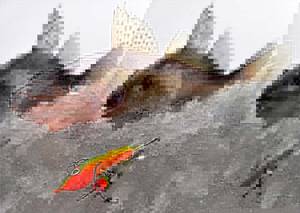
Using a jig
In order to catch pike perch in the winter months, you need to attach either a natural or artificial additional nozzle to the jig.
To do this you can:
- Choose a twister or vibrotail as an artificial one. They are made of silicone. But in winter, perhaps, an artificial nozzle made of edible silicone and attached to a jig will perform better.
- If you want to use natural bait, then you can opt for fresh sprat, various fry, sprat or pieces of any type of fish. But fishermen prefer to use sprat because of its specific smell, which makes the pike perch clearly excited. It is always worth remembering that this predator’s sense of smell is quite intensively developed.
From the point of view of fishing technique, jigs are used in combined equipment. On one line they combine:
- A tied jig and a hook with additional bait.
- Or two jigs that are tied in series.
Design features of jigs
This bait is quite heavy, so even in the presence of an intense current, it effectively reaches the bottom.
When a jig is missing, experienced anglers can use a jig head that matches the weight instead.
According to the fishing technique with a jig, the following is used:
- Passive types of fishing. In this case, it should sink to the bottom. And the fishing rod itself is placed on a special stand. The fisherman’s entire function in this case is to monitor the movement of the guard and record a bite that occurs in a timely manner. It is necessary to clearly understand that this method will only have an effect if there is a current. Since in this case, the movement of water will carry the bait along with it and cause it to move on its own.
- With an active type of fishing, the fisherman needs to play with the bait. In this case, the jig is lowered to the bottom and the bait is animated, that is, it is raised, frozen and swayed. This encourages the predator to grab the jig.
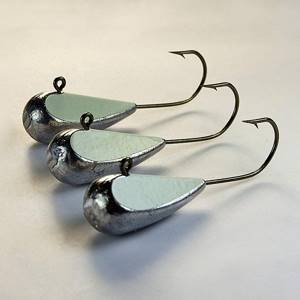
Unlike the method of fishing with a fishing rod and lure, a fishing rod with a jig must be equipped with a special nod.
Some particularly advanced fishermen, when buying a store-bought jig, want to make it additionally heavier. This is necessary when the current is quite intense. In this case, pieces of tin are soldered onto it, achieving greater mass. Then they are painted with silver paint in order to give an attractive appearance from the point of view of the fish. After which you need to attach bloodworms or a piece of fresh fish. This method achieves efficiency comparable to the method of fishing with live larvae.
Experienced fishermen also recommend feeding the jig slowly, swinging it in the layers of water near the bottom in a horizontal direction. This will interest the pike perch. If there is no bite, you can tap on the bottom. Moreover, tapping should be carried out repeatedly, maintaining short time intervals between them. At the same time, the rising cloud of turbid suspension imitates fry swarming in the ground.
If you are fishing in the current, you can try pulling the jig along the bottom. To do this, it will be necessary to lift it approximately half a meter from the bottom surface and slightly loosen the fishing line so that the current will carry it away slightly. When it settles to the bottom, you will have to pull it to a point under the hole. At the same time, as it moves, it will lift a light suspension of sand from the bottom, leaving a small groove. As soon as it is torn from the bottom again, it is at this moment that a pike perch bite can occur.
Baldu fishing technique
A bulldozer is a metal weight shaped like a cone with a truncated part and attached to a loop. On both sides of it there are two hooks that move freely along the loop. But, since this type of bait is not very attractive to pike perch, you will have to work on it to increase its value. This is done by winding it with a red thread or by stringing a brightly colored bead.
It is important to note that the hooks on both sides of the truck must be the same size. The asymmetry of the design leads to the fact that the attractiveness of the bait is significantly reduced.
The fishing technique using a bulldozer is carried out as follows:
- The bait is first lowered to the bottom.
- Then they make a sweeping movement quite smoothly.
- Then the line is released into free fall along with the weight. From which it begins to move along an oval trajectory.
- At the same time, during lowering, the hooks simultaneously on both sides begin to rise from the resistance of the water, and then fall slightly, which reminds the pike perch of the movement of small crustaceans or bugs. This is exactly what they react to, but in order to increase the attractiveness of such a bait, it is also necessary to periodically tap the bottom with it.
Fishing with a zherlitsa
This type of fishing is used as an additional one. It has a passive nature and is as similar as possible to pike fishing.
In order to implement this fishing technique, you must perform the following steps:
- Leave only one hook with bait bait on the line.
- The live bait is small fish, such as chubby, perch, roach, crucian carp and others.
- The remaining hooks are removed so as not to once again make the fish wary. This way she will be more willing to approach the bait.
- After this, you need to put a sufficient amount of fishing line on the reel. This is due to the fact that the pike perch, having grabbed its prey, will carry it a certain distance before it begins to swallow it. This behavior is typical for this predator.
Methods of fishing with sprat
Most likely, this particular method is the simplest in winter. In order to implement it, you need to prepare a sufficiently strong fishing rod and a simple reel of the inertial operating principle and perform the following steps:
- They stock up on a single piece of fishing line, the diameter of which should be 0.35 mm. If you use braided wire, you can use a thinner one.
- You will also need a sinker and a tee.
- Everything is assembled as follows - the load is fixed at the end. A leash with a tee is fixed above it at the required distance. The leash is chosen from the same fishing line as the main tackle.
- Then the freshly frozen sprat is taken and fixed on a tee, either along the back or through a transverse piercing of the body.
- The bait is supplied from the ice in the following way - it can be placed motionless on the bottom and wait until a predator approaches.
- You can periodically jerk it up, lift it approximately 25 cm and maintain a pause of one minute between these movements.
- You can play with a sprat all the time, but you must use a jig rather than a tee. This will significantly improve efficiency.
There is one mistake that inexperienced fishermen allow themselves to make. They use salted sprat, which is absolutely not allowed. Pike perch will never approach such bait. It is important to use only freshly frozen fish.
Pike-perch lures and baits
Most often, vertical spoons and balancers are used for vertical lures.
Catching pike perch in winter with a balance beam requires a fairly large bait size of 7-9 cm, and it is better to immediately replace the standard tee with a larger one, since the fanged predator grabs the bait across. The game of the balancer consists of short and sharp tosses of the bait with a fishing rod. The pause lasts 5-15 seconds. The balancer works best when the predator is active, at the beginning and end of winter. The balancer works well at a distance of 40 cm from the bottom and above.
A wide variety of winter vertical spinners allows you to successfully catch pike perch throughout the winter season.
Catching pike perch in winter with a spoon requires the angler to actively play with the rod. But in the middle of nowhere, preference should be given to spinners with slow and smooth play. The length of pike perch spoons is in the range of 5-10 cm, and their weight is 8-18 grams.
Usually two variants of the game are used.
- In the first option, the bait is smoothly lifted up by the fishing rod, and then a sharp drop is made.
- The second method of play requires a short and sharp toss of the vertical spoon and a quick return of the rod tip down.
In both cases, the duration of the pause after the fall of the spinner is 5-15 seconds.
When catching pike perch in winter with live bait , it is better to use fish such as:
- gudgeon;
- perch;
- ruff.
These are the fish that lead a bottom-dwelling lifestyle and are the natural food source of the fanged predator.
As the ice begins to melt, bleak becomes a tasty prey for pike perch. If an angler knows the migration routes of this fish, then catching pike perch will be much easier.
Catching pike perch in winter using sprat is also very effective. It can be bought in fishing stores, so this live bait is the most affordable and popular in the winter season.
Fishing with a winter float - subtleties of equipment and fishing techniques. How to choose the right float, find a place for fishing, bait and bait.
Another guide to choosing echo sounders - winter and summer models, single-beam and multi-beam, with 3D visualization, portable and coastal.
Basics of fishing tactics in winter
Naturally, it is possible to build competent tactics for hunting pike perch only if the fisherman knows well the body of water on which he is going to fish. But regardless of this:
- It all starts with the search for the fish itself.
- If a fisherman knows a river or reservoir well enough, he can choose a waiting tactic for himself. In this case, he moves from hole to hole where the predator's exit points are observed.
- If the body of water is unfamiliar, and especially if it is a large reservoir, you need to start looking for places where pike perch might come out to feed.
- This active technique is most effective if it is carried out by a whole group of fishermen and uses bait.
- If possible, it is recommended to use a fish finder to find movement under the ice and determine where fish may be passing.
If you don’t have such a device, you can use the following recommendations on where to organize searches for pike perch in winter:
Fish from ice where there is always an influx of clean and fresh water.
IMPORTANT!!! Choose a fairly uneven bottom topography with hills, piles of stones, sharp changes in elevation and ridges. It is precisely this kind of bottom that these fanged predators prefer in order to organize ambushes for their victims there.
The best bite will be observed when the first strong ice has formed, or vice versa, when the time approaches spring. This is due to the fact that during the onset of the first cold weather the predator actively hunts, continuing it from the autumn period. but when quite severe frosts have set in, the fish will go into such remote holes, from where it will be very problematic to get it. And when things move towards spring, the predator begins to become active again, it will frantically search for food for itself and rise from the depths.
Please note that if you manage to find a sufficiently fishing place, that is, to attack the pike perch trail, those who are actively fishing here can take from 1 to 2 weeks. The main thing is that during this period of time there is no sharp change in temperature, since the pike perch can change the direction of its movement.
It is best to go fishing on the first ice when the weather is sunny and the atmospheric pressure is at moderate levels or is gradually increasing. But, reaching too high readings on the barometer, the pressure will be such that the fish will go into a lethargic state and the bite will be practically absent.
Important!!! But, at the same time, fish can swallow balancers or rattlins in snowy weather, even when there is a blizzard outside.
We recommend that you read:
Winter fishing for trophy pike perch using vibrations. In crowd!
#Winter #fishing and #trophy #pike perch are parts of one whole, when you understand how to act in the icy deserts of frozen bodies of water. We found ourselves in the vast expanses of the Rybinsk Reservoir with Andrei Chulanov and luck was clearly on our side. Or maybe it’s not just luck?) About this - in the video about catching trophy pike perch using vibes, enjoy watching.
Useful things: Choosing an underwater camera for fishing in winter
Useful tips
In order to enjoy winter pike perch fishing, you need to listen to some tips:
- Do not use a balalaika fishing rod, as it is too soft to withstand such an aggressive, powerful predator as pike perch. In addition, its length will not be enough for a good hook.
- When leashes that are too long are used for a predator, it has the opportunity to spit out the bait and escape unscathed.
- At the same time, the behavior of the fisherman himself will also affect the effectiveness of the entire fishing. If you behave too loudly, stomp on the ice and talk loudly with your neighbors, he will definitely get scared and go to another, quieter place. Therefore, it is necessary to minimize all movements on ice.
- It is also advisable to get a small hook that will help you pull fish out of a narrow hole. At the same time, it will not fall down due to the fact that the hands are cold and the body of the fish is quite slippery.
- You should not use the same baits every day, even if they brought a good catch to the fisherman the day before. The fact is that this predator is diverse. Today he may prefer sprat, and the next day he will bite on the bulldozer. The fish behaves quite unpredictably, so experienced fishermen advise experimenting with a wide variety of baits to improve the bite, alternately dipping them into the ice hole.
- Use special maps to study the topography of a particular body of water. You should not miss this moment, since with its help you can note for yourself the presence of holes, edges, shallows, and flowing streams in a certain area. Studying the terrain will help you determine in advance the most promising places for fishing. What maps can be found on the Internet.
- Drill 3 to 5 holes at once and fish them. If the fish doesn’t bite, then move on to the next point.
Using these tips, winter fishing for pike perch can be made a very exciting activity, which also brings real catch.
If the material about fishing for pike perch in winter was useful, then share your opinion in the comments.
